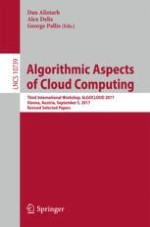2018 | Book
Algorithmic Aspects of Cloud Computing
Third International Workshop, ALGOCLOUD 2017, Vienna, Austria, September 5, 2017, Revised Selected Papers
Editors: Dr. Dan Alistarh, Alex Delis, George Pallis
Publisher: Springer International Publishing
Book Series : Lecture Notes in Computer Science
